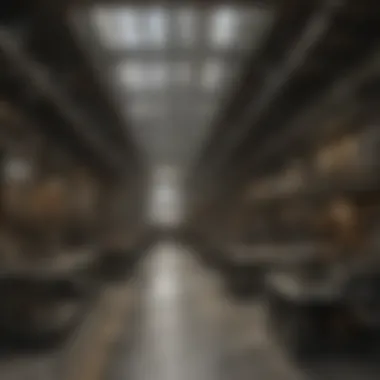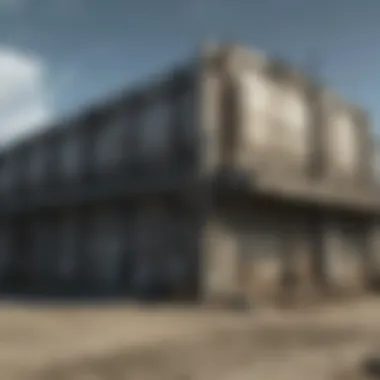Creating Effective Steel Shop Plans: A Complete Guide


Intro
Creating effective steel shop plans is vital for the success of construction and manufacturing processes. Steel structures are an integral part of many modern buildings brining strength and durability. However, an effective plan must include careful consideration regarding material selection, fabrication methods, design specifications, and timelines.
This guide aims to walk readers through the complexity of crafting these plans. We will explore the critical elements involved, useful methodologies for planning, and the overall impact these may have on the project's life cycle. While new technologies emerge constantly, the basic tenets of planning must be firmly understood. Thus, this article will also advise on best practices to help both inexperienced and seasoned professionals.
Key Components of Steel Shop Plans
Drafting steel shop plans involves several key components. Here are some elemental features:
- Design Specifications: Accurate drawings, including elevations and sections of steel elements, are essential to ensure correct interpretation by fabricators.
- Material Schedules: Listens specifications regarding grades, shapes, and sizes of steel. This document prevents any errors in procurement.
- Manufacturing Procedures: Guidelines on cutting, welding, and assembling processes aid in streamlining manufacturing.
- Quality Control: Implementation of inspection points at various stages ensures adherence to design and safety standards.
These components collectively facilitate effective communication among architects, engineers, and fabricators.
Methodologies for Creating Plans
A solid methodology can simplify the planning process and help avoid common pitfalls. Here are notable strategies for effective plan creation:
- Collaboration: Effective collaboration between all stakeholders is crucial. This can help identify discrepancies early in the process.
- Digital Tools Utilization: Software like AutoCAD or Tekla Structures improves accuracy in drawings, while also allowing for modifications easily.
- Review and Feedback Cycle: Implementing regular review points ensures that each phase of the plan is scrutinized and serves the project well.
- Risk Management Practices: Consideration of potential risks in steel fabrication helps in ensuring timely project delivery.
Creating effective steel shop plans necessitates a careful balance of these methodologies to achieve success in the project.
Impact on Project Success
The effectiveness of steel shop plans directly influences the overall effectiveness of a construction project. A well-prepared plan can lead to enhancements in:
- Cost Management: Detailed material schedules and manufacturing processes can limit unnecessary expenditure.
- Time Efficiency: Clear and accurate plans speed up the fabrication process, leading to fewer delays.
- Safety Enhancement: A well-structured plan with quality control mitigates safety risks during manufacturing and assembly.
When executed properly, these factors will significantly improve project outcomes.
Integrating Technology in Planning
The integration of technology is reshaping construction and manufacturing methodologies. Here are various ways technology is being utilized:
- CAD Software: Excellent for producing and modifying detailed construction documents.
- BIM (Building Information Modeling): Helps visualize the end product and improves workflow planning.
- Project Management Tools: Applications like Microsoft Project helps manage time efficiently and assess if projects stay on track.
Adapting and adopting these technologies can greatly enhance the crafting of steel shop plans. Non-traditional methods may introduce considerable efficiencies, facilitating the completion of projects.
Best Practices for Professionals
For both novices and veterans, adhering to certain best practices can enhance the quality of steel shop plans:
- Focus on continual learning.
- Keep communication lines open.
- Familiarize yourself with industry standards and codes.
- Stay current with technological advancements.
By keeping a finger on the pulse of these elements, professionals can yield superior results in their planning efforts.
Understanding Steel Shop Plans
Steel shop plans serve as a foundational blueprint that guides all aspects of steel fabrication and installation in construction. Effective understanding of these plans is vital for achieving both efficiency and adherence to safety regulations. This section delves into the key elements that define steel shop plans, offering insight into their purpose and overall value in the construction industry.
Definition and Purpose
Steel shop plans are detailed representations that depict various aspects of steel fabrication. These plans illustrate dimensions, material specifications, joints, welding details, and other relevant information necessary for the construction process. Unlike general architectural plans, steel shop plans focus specifically on the steel components— the skeleton of a building, in essence. They ensure that the fabrications align correctly with predetermined specifications and play a crucial role in minimizing errors during construction.
The primary purposes of steel shop plans include:
- To communicate precise fabrication specifications to the shops, ensuring that all members involved have a clear understanding of their roles.
- To outline the methods of assembly and installation, which enhances the workflow and streamlines the entire construction process.
- To serve as a point of reference during inspections and safety assessments, ensuring compliance with relevant regulations.
In summary, steel shop plans are essential, serving both an illustrative and instructional role in the fabrication process.
The Importance of Steel Shop Plans in Construction
Steel shop plans hold a significant place in construction management. Their role is often underestimated, yet they contribute substantially to project efficiency and success. A well-drafted steel shop plan not only improves communication between project teams, but also enhances predictability in material costs and timelines.


Key importance includes:
- Minimizing Fabrication Errors: Accurately prepared shop plans provide completed fabrication details, reducing the risk of mistakes that may occur during steel cutting or assembly.
- Facilitating Coordination: They improve coordination among various teams—structural engineers, fabricators, and site managers—acting as a central point for decision-making and troubleshooting.
- Adherence to Safety Standards: Ensuring compliance with safety regulations, steel shop plans can lead to more efficient inspections, thereby promoting a safer working environment.
Furthermore, inaccurate or incomplete shop plans can lead to significant delays and rework. This underscores the reason why developing robust steel shop plans deserves serious attention. Crucially, these plans contribute to the overall integrity and success of construction projects.
Key Components of Steel Shop Plans
Creating effective steel shop plans requires an understanding of several vital components. These pieces serve as the foundational elements that dictate the execution and success of any construction project. Their importance cannot be overstated; they ensure that each phase aligns with design objectives while adhering to regulatory and safety standards.
Detailed Drawings
Detailed drawings are arguably the most critical aspect of any steel shop plan. These representations provide engineers and fabricators with precise guidelines, depicting every component with importance. The drawings should clearly illustrate dimensions, connections, and assembly sequences. Errors in detailed drawings can lead to significant setbacks—both in time and budget—but clarity can enhance communication among team members.
Essential elements found in detailed drawings include:
- Construction Dimensions: Size and shape of each steel member must be explicitly defined.
- Connection Details: These show how different steel parts fit together. Effective connections are necessary for structural integrity.
- Assembly Instructions: Step-by-step guidelines for putting together elements on-site.
In essence, detailed drawings act as a visual language both for fabricators and construction teams.
Material Specifications
The section on material specifications delves into the qualities and characteristics required for the materials used in steel construction. Each member type has unique physical properties, and these specifications will impact the safety and longevity of the entire structure. Knowing the appropriate grade of steel, for example, affects both cost and structural performance.
Key material specifications must include:
- Steel Grade and Type: Information relating to the specific steel used (e.g., ASTM A36).
- Tolerances: Sets requirements for acceptable deviations in dimension.
- Finish and Coating Information: Explains which treatments have been applied, such as galvanizing or paint, that can affect resistance to corrosion and overall durability.
Being precise about these specifications supports quality control and helps prevent future material-related problems.
Welding and Fabrication Methods
The methods of welding and fabrication are also central to creating effective steel shop plans. Comprehensive illustrations lay the foundation, but knowledge of acceptable welding and fabrication practices ensures that all components hold together under load. By outlining precise welding standards, the plans ensure that every joint can optimize strength without jeopardizing materials.
Important considerations include:
- Welding Process Description: Identifying whether techniques like MIG or TIG will be used based on the application.
- Joint Types: Documentation of butt, fillet and groove joints specifies how components should be connected.
- Heat Treatment Requirements: Specifies whether any pieces need heat treatment to regain strength or remove constraints.
Defining these parameters reduces the risk of issues on site and enhances the craftsmanship of the final structure.
Ensuring attention to all these key details in steel shop plans is vital for protecting the integrity of the overall project and safeguarding investments.
In summary, the key components of steel shop plans—the detailed drawings, material specifications, and fabrication methods—work collectively to lay the groundwork for construction successfully. They represent not just technical requirements but also embody strategies for effective project management.
Developing Steel Shop Plans
Developing steel shop plans is a crucial process in the construction and fabrication industries. Effective plans lead to improved efficiency on the job site and reduce waste of materials. This phase ensures that all aspects of the construction meet the required standards and specifications. The significance of developing thorough shop plans cannot be overstated as they are foundational to the overall success of any structural project.
Throughout this article, it becomes evident that the elements involved in creating effective plans need careful consideration. Factors such as dimensional accuracy, material choice, and fabrication techniques directly influence the quality of the final product. By addressing these elements during the planning stages, professionals can foresee complications that may arise during construction.
Steps in Creating Effective Plans
Creating effective steel shop plans involves a series of well-defined steps. Each step plays a vital role in ensuring the plans are not only comprehensive but also practical. Key steps include:
- Client Consultation: Engage with the client to understand their specific needs and project requirements.
- Initial Assessments: Gather site information and existing conditions to inform design decisions.
- Preliminary Design: Draft initial sketches or models based on gathered data and project specifications.
- Review and Feedback: Allow time for client input and make necessary revisions.
- Finalization and Detailing: Compile the detailed drawings and necessary specifications before submission.
- Documentation: Ensure all materials are documented, including compliance with regulatory standards.
By methodically following these steps, it becomes possible to create plans that reduce errors and enhance collaboration.
Software and Technology Tools
In today's digital age, software and technology tools play a significant role in steel shop planning. Utilizing advanced software increases drafting efficiency and accuracy. Notable tools that can assist in developing steel shop plans include:
- AutoCAD: Widely used for creating precise 2D and 3D drafts.
- Tekla Structures: Purpose-built for managing complex steel structures and providing detailed fabrication drawings.
- Revit: A building information modeling software that assists in visualization throughout construction.
- SolidWorks: Useful for simulations and understanding the mechanical aspects of designs.


These tools not only streamline the drawing process but also facilitate collaboration among project teams. Continued education on technological advancements is essential for professionals to maintain their competitive edge.
Collaboration Techniques
Collaboration is essential in steel shop planning. The increasingly complex nature of projects necessitates harmonized efforts among various stakeholders including architects, engineers, and fabricators. Effective collaboration techniques involve:
- Regular Meetings: Schedule consistent updates between all parties to review progress and address concerns.
- Digital Platforms: Leverage project management tools like Trello or Slack for communication.
- Shared Documentation: Use cloud services to allow quick access to plans and revisions by all team members.
These techniques enhance the entire workflow, ensuring everyone involved is aligned with the project’s objectives and timelines. The failure in variety or clarity can result in inaccuracies and redundant work during fabrication.
“Effective steel shop planning combines precision, teamwork, and advanced tools to ensure construction success.”
Through these practices, the objective of developing precise steel shop plans becomes achievable, while embracing ongoing learning and adaptability will benefit all participants involved.
Challenges in Steel Shop Planning
Planning steel shop designs can be overooming due to varioud factors. It is vital to acknowledge the challenges that can arrose during this process. A thorough understanding of these challenges can lead to romified plans resulting in better construction aw procedures. Thus, addressing these issues directly contributes to overall project efficacy and helps mitigate possible disruptions in timelines and resources.
Common Obstacles and Solutions
While creating effective steel shop plans, professionals often encounter several common obstacles. Identifying these hurdles is the first step toward effective solutions. Here are some frequent challenges faced:
- Coordinate Conflicts: Misalignment between design intent and construction specifications may occur, especially in complex edifices.
- Regulatory Compliance: Navigating local regulations can be daunting. Plans must comply with stringent safety and design standards.
- Resource Limitations: Availability of skilled labor and materials can hinder progress and efficiency.
Each of these obstacles has possible solutions within reach:
- Implement Multi-disciplinary Reviews: Ensure stakeholders are actively involved and communicate frequently.
- Utilize Compliance Checklists: Leverage tools to cross-verify regulations, minimizing the risk of oversight.
- Engage in Resource Planning: Build strong relationships with suppliers and utilize predictive hiring practices to address potential shortages.
Solutions not only resolve issues but also prevent contagion of future dis difficulties.
Impact of Inaccurate Plans
The consequences associated with inaccuracies in steel shop plans can unfold in countless dreadful ways. Errors in planning affect cost, time, and quality outcomes.
- Budget Overruns: Mistakes in initial calculations can spiral costs unmanageable. Additional material orders and re-work lead to financial drain.
- Schedule Delays: Confusion stemming from plan inaccuracies may disrupt existing timelines, negatively impacting overall project delivery.
- Quality Risks: Poor or miscommunication can present risks in product quality, which leads back to reputational damage.
Proper planning minimizes risks and avoids cascading errors in project execution.
Continuous emphasis on accuracy and review mechanisms can facilitate smooth operational flows, enhancing overall trust in fabricated steel components.
Quality Control in Steel Fabrication
Quality control in steel fabrication plays a crucial role in ensuring the longevity and safety of structures. Effective steel shop plans must incorporate robust quality control measures that account for both the fabrication processes and the final product. The importance lies in minimizing errors, reducing risks, and driving overall efficiency. When engineers and designers emphasize quality control, they ensure adherence to specifications, maintenance of standards, and mitigation of costly mistakes that can arise during construction.
Standards and Regulations
Standards and regulations form the backbone of quality assurance in steel fabrication. The industry often follows established codes, such as those set by the American Institute of Steel Construction (AISC) or the International Organization for Standardization (ISO). These guidelines dictate the required specifications for materials, dimension tolerances, and testing protocols. Moreover, adhering to these standards helps fabricators qualify their work for inspection processes, thereby securing necessary certifications.
The following points outline the significance of upholding these standards:
- Consistency: Standardized procedures ensure a uniform level of quality across projects.
- Safety: Regulations address safety concerns at every stage of fabrication, minimizing failure risks.
- Reputation: Construction entities known for compliance with standards often enjoy better market credibility.
- Legal Requirements: Failing to meet legal standards can result in substantial legal ramifications.
Inspection Methods
Inspection methods are pivotal to the quality control process in steel fabrication. Various techniques can be employed to assess the quality of materials and workmanship throughout different stages of fabrication. Ensuring proper inspections can catch discrepancies before they escalate into major issues.
Some widely used inspection methods include:
- Visual Inspection: A straightforward method that allows for detecting obvious defects, such as cracks and weld failures.
- Ultrasonic Testing: This technology uses sound waves to identify internal flaws and assure proper weld penetration. It is highly effective for thicker steel sections.
- Magnetic Particle Testing: Often utilized for detecting surface and near-surface defects in ferromagnetic materials, this method is indispensable in quality assurance.
- Radiography: This approach uses X-rays to view the internal structure of welded joints, providing comprehensive insight into any hidden defects from fabrication.
Insight: Choosing the right inspection method based on the project’s complexity and requirements is paramount for timely identification of potential issues.
Implementing these inspection methods makes for a formidable quality control strategy that enhances project success. For detailed guidelines on methods suited for specific applications, consult resources from the American Welding Society or International Steel Fabricators Association.


In summary, by integrating stringent quality control through standards and inspection methods, fabrication processes become more reliable. Effective shop plans prioritize these aspects, ultimately leading to successful project completion.
Future Trends in Steel Shop Planning
The landscape of steel shop planning is undergoing rapid evolution. As technology advances and environmental considerations become paramount, understanding future trends is crucial for professionals aiming to remain competitive in the industry. This section unveils significant developments that impact how steel shop plans are created and implemented, emphasizing prioritizing innovation while maintaining efficiency.
Emerging Technologies
Emerging technologies are reshaping the methods used in steel shop planning. Tools such as Building Information Modeling (BIM) enable a more integrated approach, enhancing communication between architects, engineers, and fabricators. By visualizing the entire project in a three-dimensional space, teams can identify issues early in the process, reducing costly revisions.
Other technologies include the use of drones for surveying construction sites. Drones provide accurate measurements and real-time imaging, aiding in project assessments and progress monitoring. This data integration enhances precision in steel fabrication, allowing professionals to work more effectively.
Moreover, advancements in manufacturing techniques, such as additive manufacturing or 3D printing, are beginning to influence steel fabrication. This technique allows for producing parts with complex geometries that were difficult to achieve using traditional methods. It leads not only to novel designs but also offers opportunities for material reduction and cost savings.
Key Benefits of Adopted Technologies
- Enhanced accuracy in planning and fabrication.
- Improved collaboration among diverse project teams.
- Higher flexibility in design, allowing for changes to fit project needs.
Sustainability Practices
Sustainability in steel shop planning is no longer an option but a necessity. The construction sector is responsible for a significant carbon footprint, so adopting sustainable practices can greatly reduce environmental impact. Steel professionals are embracing strategies such as reducing waste through efficient resource management.
Implementing closed-loop recycling systems is an example of these green efforts. Innovations in recycling steel scrap make processes less resource-intensive and mitigate the environmental effects of sourcing new materials. Moreover, engineers are now opting for sustainable materials in plans whenever possible.
Additionally, firms are increasingly adhering to sustainability certifications. These certifications provide standardized indicators of eco-friendliness in construction processes. Achieving these can enhance a company’s reputation and attract clients who value social responsibility.
“Sustainability in steel planning fosters both environmental and economic benefits.”
Engaging in sustainability practices can provide several advantages:
- Reduces material costs through recycling and reusing resources.
- Helps in compliance with governmental regulations on constructions.
- Attracts organizations interested in environmentally friendly procedural oversight.
Case Studies of Successful Steel Shop Plans
Exploring case studies of successful steel shop plans provides valuable insights into best practices and effective methodologies in the field of construction. These case studies reveal how exceptionally executed steel shop plans can optimize fabrication processes, minimize costs, and enhance project efficiency. By analyzing real-world examples, professionals can see the practical implications of the theories discussed in previous sections.
Analysis of Notable Projects
In recent years, various notable projects have showcased the importance of sound steel shop planning. For instance, the One World Trade Center project employed an integrated steel shop plan. This plan emphasized detailed drawings and accurate material specifications to ensure compliance with the highest structural thresholds. The project harnessed advanced fabrication technologies, facilitating precision and reducing wastage. By conducting thorough inspections at every stage, the planning team was able coordinate complex assembly tasks effectively, resulting in timely project delivery despite an intricate architectural design.
Similarly, the Sydney Opera House serves as another case study where effective steel shop planning contributed significantly to success. The unique curvature of its roof demanded precision. Collaborative techniques were key; planners took full advantage of digital tools to rebuild complex geometries into straightforward 2D and 3D formats. Effective communication among the engineers, architects, and fabricators ensured crucial adjustments were made seamlessly as the project progressed.
Notable Elements of Success:
- Collaboration: Engagement among architects, engineers, and steel fabricators.
- Tie to Technology: Use of modern design software and modeling tools.
- Emphasis on Quality Control: Consistent monitoring and adjustment processes.
Lessons Learned
The lessons from these prominent steel shop plans reveal enhancements in construction methodologies that resonate across various projects. Among the key takeaways from these case studies are:
- Importance of Comprehensive Planning: Detailed initial plan outlines foster better resource allocation, aiding efficient workflow and timeliness.
- Adaptability: Projects must maintain flexibility as specifications or design changes arise during fabrication.
- Strategic Use of Technology: Integrating BIM (Building Information Modeling) or CAD (Computer-Aided Design) brings greater accuracy and efficiencies to planning and production.
Well-planned steel shop documents yield smoother construction processes that adapt to emergeing challenges.
Implementing ideas and strategies showcased in these case studies not only enhances individual projects but also raises overall industry standards. Hence, analyzing successful plans serves as an enduring source of inspiration and guidance for both seasoned veterans and newcomers alike.
The essential aspect of advancing steel shop planning inherently comes through reflective learning, thereby ensuring progress, efficiency, and efficacy throughout various phases of construction and fabrication.
Ending
In this article, we have examined the essence of steel shop plans and their pivotal role in the construction industry. Creating effective steel shop plans is not just about drawing lines and marking dimensions; it is about ensuring precision, safety, and efficiency in building structures.
Summarizing Key Insights
Steel shop plans serve multiple purposes, providing detailed instructions for construction while also facilitating communication among all parties involved. A few key elements stand out:
- Detailed Drawings: These should accurately convey the specifications and dimensions essential for fabrications and installations.
- Material Specifications: Clearly defining materials prevents errors that can cause safety hazards or additional costs.
- Quality Control: Setting standards and conducting inspections ensures that the final product meets industry regulations.
Moreover, applying collaborative techniques throughout planning helps bring diverse expertise to the forefront. Projects often succeed when stakeholders feel invested. The inclusion of emerging technologies, such as Building Information Modeling, carries a significant future advantage by optimizing workflows and minimizing potential delays.
Effective steel shop plans are more than just plans; they are foundational elements that guide the entire construction process. As practiced professionals engage in ongoing learning and adaptation, understanding these key insights will contribute to their success and that of their projects, leading to safer and more timely completions.







